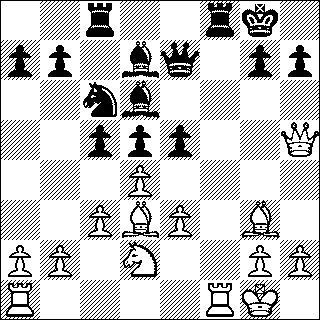 I've broken the "2000 barrier" at ICC correspondence. WooHoo!
I've broken the "2000 barrier" at ICC correspondence. WooHoo!Earlier, I stated that I had tried the London System and had found it wanting for correspondence chess. Despite that, it seems that I am getting the better position in some games using the London. In others the opponent is simply misplaying the position. Regardless of the success I've had with the London, I still think I will not use it in correspondence from here out. It seems to me that I have had to grind out each game in this system and it hasn't been fun. Enjoyment is in itself perhaps the best factor in choosing an opening system.
[Event "ICC correspondence 2007Seven.02.05"]
[Site "Internet Chess Club"]
[Date "2007.08.25"]
[Round "-"]
[White "sdo1"]
[Black "az2112"]
[Result "1-0"]
[ECO "D02"]
[WhiteElo "1956"]
[BlackElo "1592"]
[Opening "Queen's pawn game: London System"]
[NIC "QP.08"]
1. d4 d5 2. Nf3 Nf6 3. Bf4 e6 4. e3 c5 5. c3 Nc6 6. Nbd2 Bd6 7. Bg3 O-O 8. Bd3 Qe7 9. Ne5 Nd7 10. f4 f6 11. Nxd7 Bxd7 12. O-O Rac8 13. Qe2
 This is another good London System setup. Black, when playing against the London, must always be on guard for tactics against his King side pawns, particularly the h7 pawn. Here, the protective g6 Knight is gone and the light Bishop has sighted in on h7. The Queen has free access to the light King side squares and can easily join an attack on h7 if Black ignores the weakness. Otherwise, Black has a good position and can defend, as long as he defends accurately. Black is well on his way to equalization and has possibilities of an attack after his King is secured. Some would say that Black even stands a bit better in this position. Black's pawns have more flexibility, his pieces are more central, and he has the promise of a center break at his time of choosing. Unfortunately, for Black, he chooses to try the break too soon.
This is another good London System setup. Black, when playing against the London, must always be on guard for tactics against his King side pawns, particularly the h7 pawn. Here, the protective g6 Knight is gone and the light Bishop has sighted in on h7. The Queen has free access to the light King side squares and can easily join an attack on h7 if Black ignores the weakness. Otherwise, Black has a good position and can defend, as long as he defends accurately. Black is well on his way to equalization and has possibilities of an attack after his King is secured. Some would say that Black even stands a bit better in this position. Black's pawns have more flexibility, his pieces are more central, and he has the promise of a center break at his time of choosing. Unfortunately, for Black, he chooses to try the break too soon. 13. ...e5? 14. fxe5 fxe5 15. Qh5
 This is the result of the early ...e5. The Queen invades and there is no good way to prevent the Bishop's attack resulting in either a won pawn with a fractured King side, or a Bishop sac for a complete removal of the two protective King pawns.
This is the result of the early ...e5. The Queen invades and there is no good way to prevent the Bishop's attack resulting in either a won pawn with a fractured King side, or a Bishop sac for a complete removal of the two protective King pawns.15. ...g6 16. Bxg6 hxg6
Other tries were ...Bb8 and ...Qg7.
17. Qxg6+ Kh8 18. Qh6+ Kg8 19. Bh4 Qe6
This was simply a flier for Black. He will certainly lose material anyway, this desperado was worth trying.
20. Bf6 Kf7? 21. Qh5+ Kg8 22. Qg6#
20...Kf7 leads directly to mate.
The lesson in this game is glaring, Black must always guard against an attack on his h7 when White exchanges off the g6 Knight in the London. Against this system, it is probably best not to post the Queen Knight aggressively to c6, but instead to d7 where it supports the defense of the King side and a c5 push. The London player, much like the Colle player, is looking to attack the g and h pawns in front of the King. The light Bishop, while having as his first duty the support of the e4 push, is optimally poised to take advantage of the absence of a g6 Knight, and with the Queen makes a happy battery to hammer at h7.

Steve, what do you use to generate your diagrams? They look a lot like those in books and newspapers.
ReplyDeleteAnd congratulations on breaking 2000. :)
Thanks!
ReplyDeleteI use ChessPad (available for download at http://www.wmlsoftware.com/download.html) to generate the diagrams and to store my CC games.
Steve,
ReplyDeleteYou really should move away from the London System to the Torre Attack. It's similiar to the London except the Bishop sits on g5 instead on f4. The Torre Attack is less static in that it goes after the black queen. A good example of this is Torre v Lasker, Torre v Saemisch (both Moscow 1925). Also Petrosian and Spassky have some good matches with this line as well.